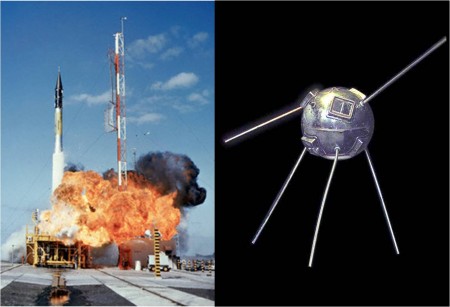Fifty-five years ago this month, the United States attempted to launch the nation’s first satellite in response to the Soviet Union’s recent orbiting of Sputnik I. Unfortunately, the Vanguard TV-3 launch vehicle lost thrust moments after lift-off and exploded on the launch pad.
The International Geophysical Year (IGY) was a cooperative international scientific effort whose goal was to study the physical properties of the Earth. A total of sixty-seven (67) countries participated in the IGY which involved experimentation in eleven (11) physical science categories. The IGY lasted from 01 July 1957 to 31 December 1958.
Project Vanguard was established in 1955 by the United States for the purpose of orbiting the nation’s first satellite during the IGY. The Naval Research Laboratory (NRL) managed the project with the Martin Company, General Electric, Aerojet General and Grand Central Rocket Company as contractors.
Project Vanguard involved the development of both the launch vehicle and satellite payload. The Martin Company was the prime contractor for the Vanguard 3-stage launch vehicle while the NRL developed various Vanguard satellites. Launch took place from Cape Canaveral, Florida.
The Vanguard Satellite Launch Vehicle (SLV) was based on the design and technology of Martin’s single-stage Viking rocket. The SLV measured 75 feet in length and had a maximum diameter of 3.74 feet. Lift-off weight was 22,156 lbs. First, second and third stage average thrusts were rated at 30,303 lbs, 7,599 lbs and 2,599 lbs, respectively.
The original Vanguard satellite weighed a mere 3.25 lbs and included seven (7) mercury cell batteries, a pair of tracking radio transmitters, a temperature sensitive crystal, and six (6) solar cells mounted to its external surface. A total of six (6) data transmission and space tracking antennas protruded from the satellite’s spherical body as well.
On Friday, 04 October 1957, the Soviet Union orbited the world’s first artificial satellite, Sputnik I. Then, on Sunday, 03 November 1957, the Soviets orbited Sputnik II with the mongrel dog Laika onboard. These twin space feats both impressed the world and stunned the United States. As a result, success with Project Vanguard took on more significance and emphasis shifted to getting America into space pronto.
Vanguard Test Vehicle No. 3 (TV-3) was America’s first attempt to launch a Vanguard satellite into earth orbit. In truth, neither the Vanguard project nor Vanguard SLV was ready for the mission. However, the pressure to get America into space forced the project to expedite its carefully planned, but time-consuming flight test schedule. The results of doing so would not be good.
On Friday, 06 December 1957, Vanguard TV-3 lifted-off at 16:44:34 UTC from LC-18A at Cape Canaveral, Florida. Then, just 4 feet above the launch pad and 2 seconds into flight, the rocket’s first stage rocket motor lost thrust. TV-3 fell back onto the pad, rupturing its propellant tanks. The resulting massive explosion and fire totally consumed the vehicle and severely damaged the launch pad.
The TV-3 launch attempt was televised live to a worldwide audience numbering in the millions. Interestingly, the tiny Vanguard satellite somehow survived the post-crash inferno and was discovered intact at the edge of the launch complex apron. Though no longer flightworthy, the plucky satellite was dutifully beeping away as though it were in space.
The public response to the failed TV-3 mission was immediate and brutal. The ne’er-do-wells in the American press corps referred to the event with such delightfully derogatory terms as “Oopsnik”, “Kaputnik”, “Flopnik” and “Stayputnik”. However, the unkindest cut of all came from the mouth of Soviet Premier Nikita Khrushchev who mockingly described the diminutive Vanguard satellite as America’s little grapefruit.
The Vanguard Program would eventually see success. Indeed, the first Vanguard satellite (Vanguard 1) reached orbit on Monday, 17 March 1958. In fact, that satellite is still in space and is expected to remain there for at least two hundred more years. However, Vanguard 1 was Amerca’s second satellite to achieve orbit. The distinction of being first goes to the United States Army’s Explorer I satellite which was carried into orbit by a Jupiter-C launch vehicle on Friday, 31 January 1958.


